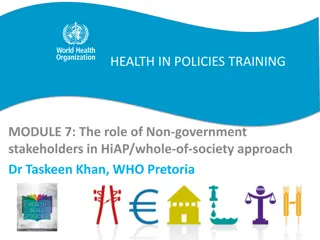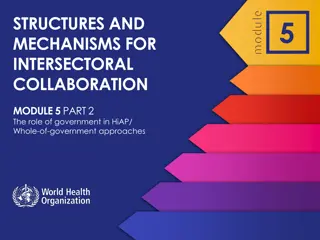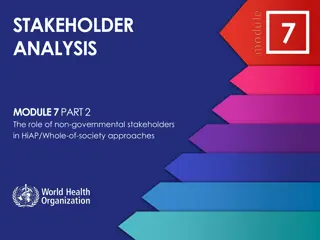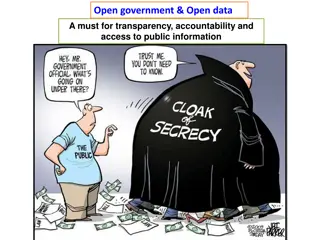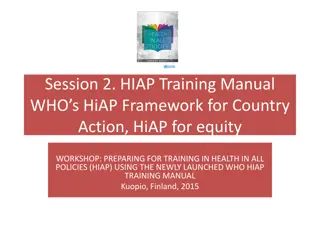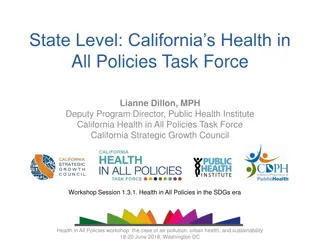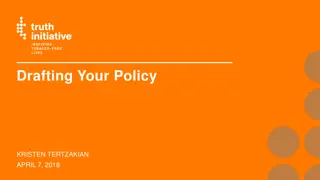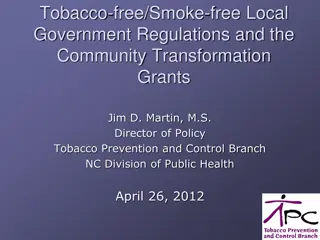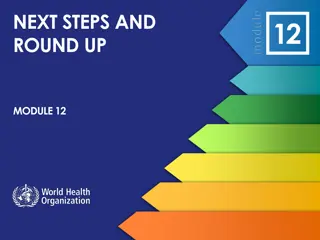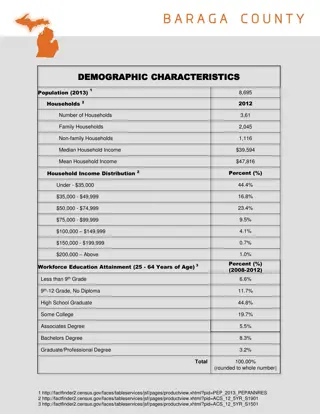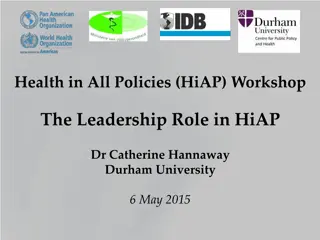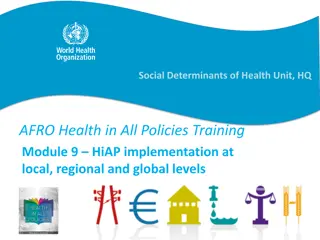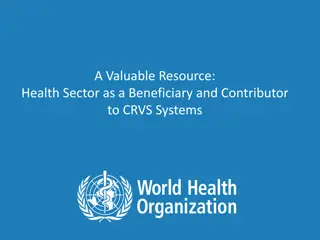The Role of Government in Health in All Policies (HiAP) Approach
Governments worldwide face major challenges like climate change and obesity, requiring collaborative, innovative solutions. The Health in All Policies (HiAP) approach emphasizes government responsibility for population health through stakeholder engagement, research commissioning, policy formulation, implementation, and impact evaluation.
Uploaded on Sep 09, 2024 | 0 Views
Download Presentation

Please find below an Image/Link to download the presentation.
The content on the website is provided AS IS for your information and personal use only. It may not be sold, licensed, or shared on other websites without obtaining consent from the author.If you encounter any issues during the download, it is possible that the publisher has removed the file from their server.
You are allowed to download the files provided on this website for personal or commercial use, subject to the condition that they are used lawfully. All files are the property of their respective owners.
The content on the website is provided AS IS for your information and personal use only. It may not be sold, licensed, or shared on other websites without obtaining consent from the author.
E N D
Presentation Transcript
5 THE ROLE OF GOVERNMENT IN THE HiAP APPROACH MODULE 5 PART 1 The role of government in HiAP/ Whole-of-government approaches
LEARNING OBJECTIVES 5 Describe the role of government in the HiAP approach 1 Recognize a range of terms that refer to intersectoral action 2 Explain some of the barriers to closer intersectoral collaboration 3 Describe conditions conducive for intersectoral collaboration 4
GOVERNMENTS HAVE A RESPONSIBILITY FOR THE HEALTH OF THE POPULATION 5 Health is a state of complete physical, mental and social well-being, and not merely the absence of disease or infirmity; Health is an individual right and a social justice issue; Health is a public good; and Governments have a responsibility for the health of their peoples.
GOVERNMENTS AROUND THE WORLD ARE FACING MAJOR SOCIETAL CHALLENGES 5 Issues, like climate change and obesity, have been termed wicked problems as they have complex causes and require innovative, collaborative solutions to be applied systemically if they are to be resolved. This means governments need to rethink the way they do business, they need to encourage collaboration across sectors and promote joined-up government responses to complex policy problems.
5 WHOLE OF GOVERNMENT The whole-of-government approach emphasizes not only the need for better coordination and integration of government activities, but aims for this coordination and integration to be centred on overarching societal goals of the government. Health in All Policies is one type of whole-of-government approach to prioritize governance for health and well- being involving more than the health sector and working in all directions. The approach considers the impact of non- health sectors on health and the impact of health on other sectors and synergistic policies for greater well-being.
THE ROLE OF GOVERNMENT IN HiAP 5 Given government responsibility for health and the complexity of many contemporary health challenges, governments have several important roles to play in the HiAP approach: Engaging stakeholders within and beyond government; Commissioning research; Formulating and implementing intersectoral policies; and Evaluating their impact.
SUPPORT THE SCALE-UP OF INTERSECTORAL INTERVENTIONS 5 Governments must bring about a shift from issue-specific driven ways of working across sectors and low levels of integration to a systematic approach for policy development=joint policies HiAP BECOMES A SYSTEM FOR POLICY-MAKING Cooperation Information Integration Coordination HEALTH IN ALL POLICIES Cooperation Interdependency and budget integration Information Autonomy loss, resource sharing & enhanced formality Coordination Integration Source: Adapted from, Demonstrating a health in all policies analytic framework for learning from experiences: based on literature reviews from Africa, South-East Asia and the Western Pacific , WHO, 2013. Compatibility & accessibility
5 HEALTH IS A POLITICAL CHOICE REQUIRES COMMITMENT FROM GOVERNMENT AND AN INVESTMENT OF RESOURCES
5 ACCOUNTABILITY Government needs to be accountable and hold its agencies to account the health sector cannot play this role Californian example Executive Order established the HiAP Taskforce under the auspices of the Strategic Growth Council, a cabinet-level body to oversee collaborative work across public agencies
5 ACCOUNTABILITY: EXAMPLE California Health in All Policies Task Force Strategic Growth Council Purpose: Transform culture of government; embed health, equity, and environmental sustainability into agency operations; foster collaboration. Purpose: Enhances collaboration between State agencies in their work to advance sustainable communities. Members: Air Resources Board; Office of the Attorney General; Business, Consumer Services, and Housing Agency; Department of Community Services and Development; Department of Corrections and Rehabilitation; Department of Education; Environmental Protection Agency; Department of Finance; Department of Food and Agriculture; Department of Forestry and Fire Protection; Department of General Service Government Operations Agency; Health and Human Services Agency; Department of Housing and Community Development; Labor and Workforce Development Agency; Natural Resources Agency; Department of Parks and Recreation; Office of Planning and Research; Department of Social Service; Department of Transportation; Office of Traffic Safety; Transportation Agency. Role: Per Governor s Executive Order, provides accountability and oversight for the Task Force. Members: Secretaries of Environmental Protection agency, Natural Resources Agency, State Transportation Agency, Business, Consumer Services, and Housing Agency, Health and Human Services Agency, Department of Food and Agriculture, Governor s Office of Planning & Research, three public members.
BARRIERS TO SUCCESSFUL INTERSECTORAL COLLABORATION WITHIN GOVERNMENT 5 Distracted or unstable leadership; Conflicting personalities; Fragmented government functions; Sub-national geographical and government jurisdiction divisions; Sectors appearing to have competing interests; Limited or misused resources (staff, funding, etc.); and Restricted policy space.
FAVOURABLE CONDITIONS FOR EFFECTIVE INTERSECTORAL COLLABORATION WITHIN GOVERNMENT 5 Government supports and encourages intersectoral action; Sectors have shared interests or both/all benefit from cooperation; Issue has high political importance and requires urgent addressing; Intersectoral action is well planned with clear objectives, roles and responsibilities; Laws exist or are planned to support the proposed policy; Sufficient resources are available; and There are plans to monitor and sustain outcomes. Proposed policy has public support; Strong, effective leaders in the bureaucracy (policy champions/entrepreneurs);
End of Module 5 Part 1 Please continue to Module 5 Part 2





